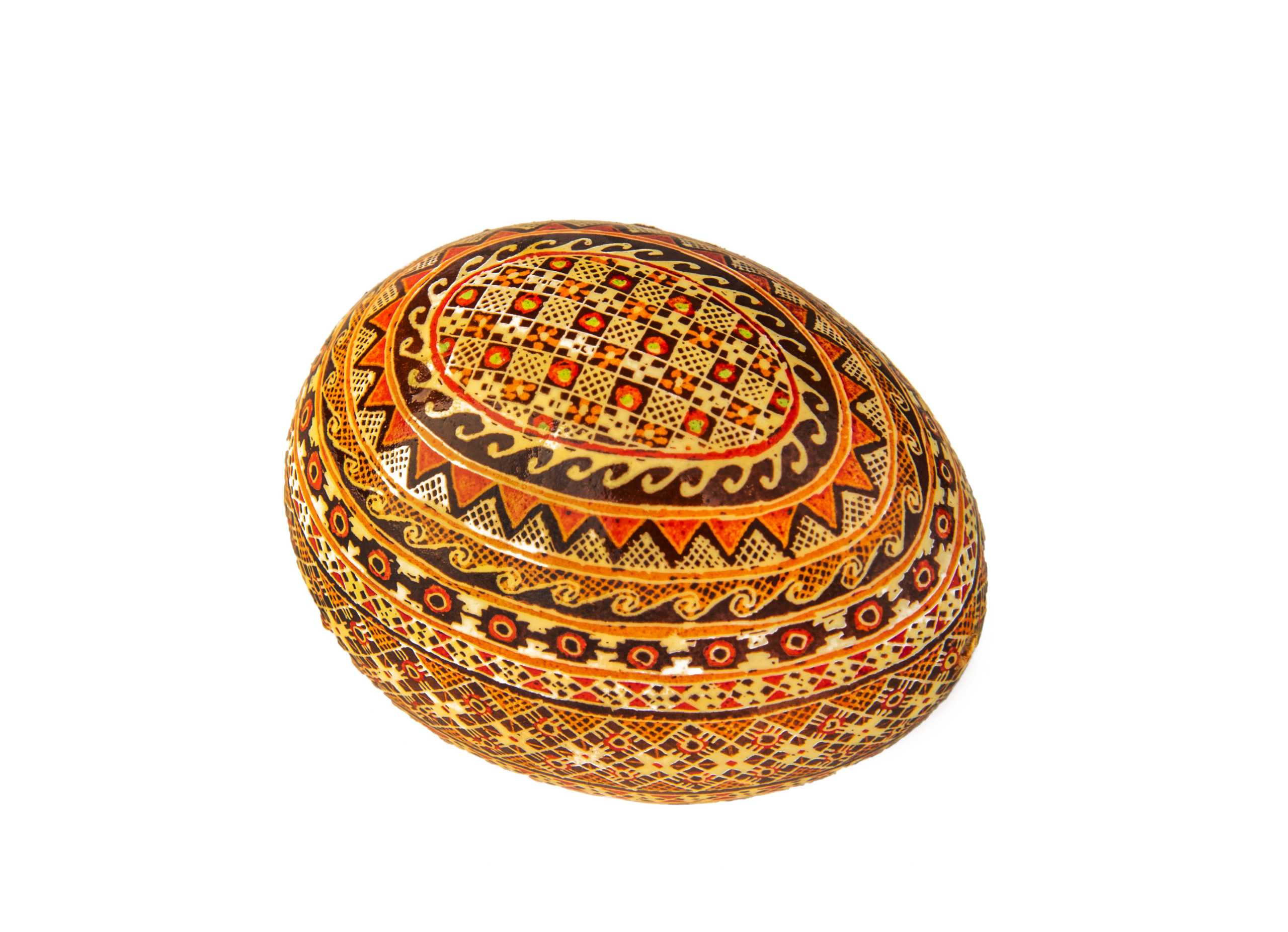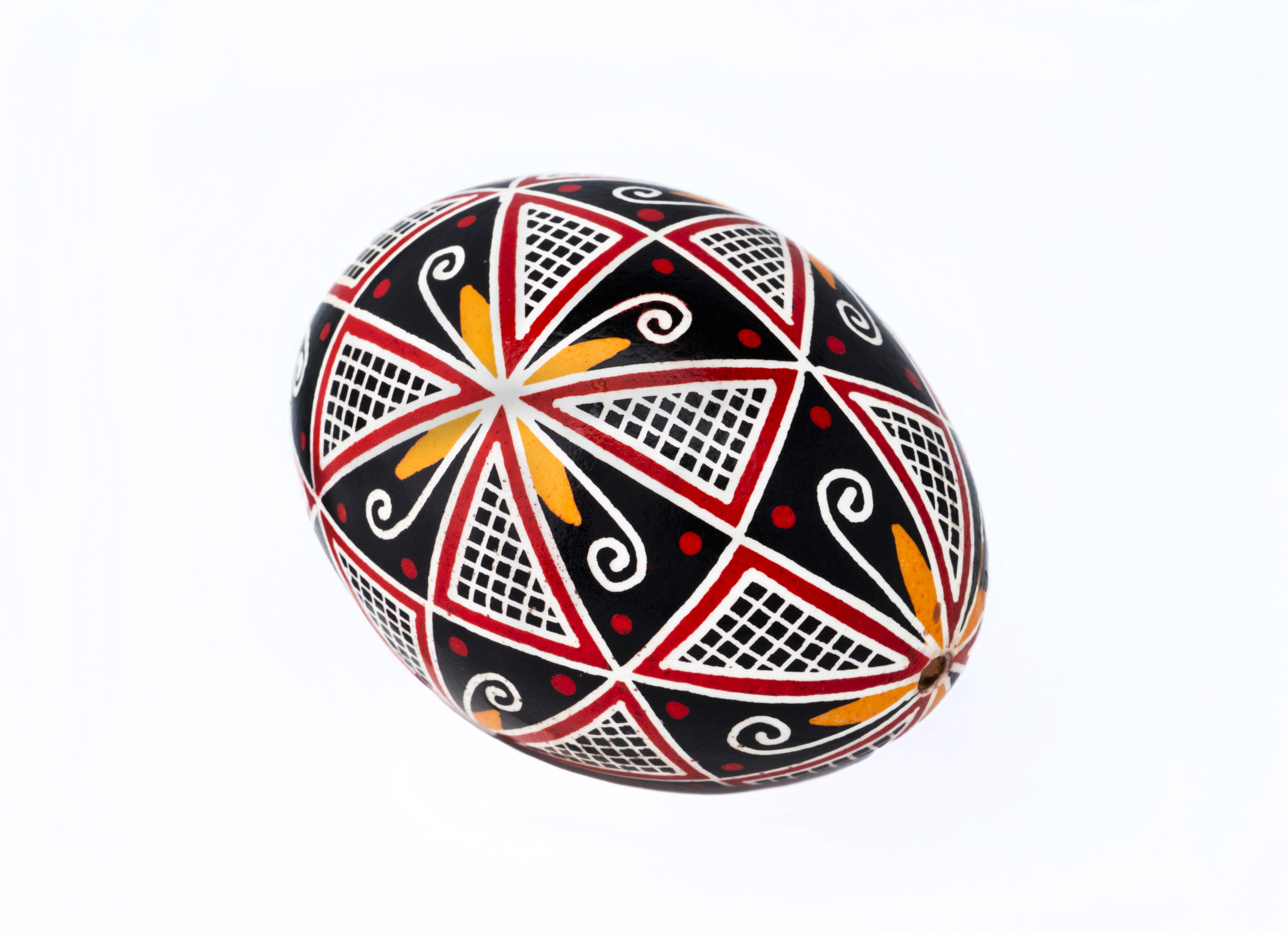Ukrainian Easter Egg
Artifact
Image
Video
Audio
 Activities
Activities
LOOK
Look closely at this object. What do you think it is used for? Verify your answer by reading the Historical Context below.
Details
 Materials
Materials - Eggshell
Historical Context
Choose one of the three levels below to match your needs.
- This is a Ukrainian Easter egg, known as a pysanka. Intricately designed and richly coloured, pysanky have been part of Ukrainian culture for centuries.
- The design is “written” on the eggshell in molten wax, using a stylus, before dyes are applied. As in batik, the wax stops the dye from penetrating certain areas.
- Over 170,000 Ukrainians came to Canada between 1891 and 1914. Like many immigrant groups, they strove to adapt and maintain their distinctive cultural, linguistic and religious traditions, while at the same time committing themselves wholeheartedly to their new home and country: Canada.
Scroll through the media carousel above to see a picture of the pysanky included in the History Box and information about the artist who made them.
This is a Ukrainian Easter egg, known as a pysanka. Intricately designed and richly coloured, pysanky have been part of Ukrainian culture for centuries. After Christianity spread in the Ukrainian region around the 10th century, pysanky designs took on associations related to Easter and the Resurrection.
The Ukrainian name for the eggs comes from the verb pysaty, which means “to write.” The design is “written” on the eggshell in molten wax, using a stylus, before dyes are applied. As in batik, the wax stops the dye from penetrating certain areas.
This egg was made by Doris Yanda (1905–2005), a first-generation Ukrainian Canadian. Over 170,000 Ukrainians came to Canada between 1891 and 1914. Like many immigrant groups, they strove to adapt and maintain their distinctive cultural, linguistic and religious traditions, while at the same time committing themselves wholeheartedly to their new home and country: Canada
This is a Ukrainian Easter egg, known as a pysanka. Intricately designed and richly coloured, pysanky have been part of Ukrainian culture for centuries.
Pysanky were once believed to have a magical ability to ward off evil spirits. After Christianity spread throughout the Ukrainian region around the 10th century, their designs took on associations related to Easter and the Resurrection.
The Ukrainian community in Canada has developed this traditional craft into a vivid cultural symbol, and a source of ethnic pride. The rich decorative heritage of pysanky gives Ukrainian egg artists enormous scope for originality.
The Canadian Museum of History has more than 1,500 pysanky in its collection. Among the myriad ornamental motifs are symbols drawn from solar, plant, animal and religious sources.
The Ukrainian name for the eggs comes from the verb pysaty, which means “to write.” The design is “written” on the eggshell in molten wax using a stylus, before dyes are applied. As in batik, the wax stops the dye from penetrating certain areas.
This egg was made by Doris Yanda (1905–2005), a first-generation Ukrainian Canadian born in Gimli, Manitoba. Yanda dedicated her life to Canada and the preservation of Ukrainian culture. She grew up in Saskatchewan and had a long career as an artist, published poet and community leader. In 1995, Yanda’s daughter donated 186 artistic works made by her mother, including cushion covers, traditional Ukrainian shirts, wall hangings, scarves and almost 30 pysanky eggs. The Museum’s library also has a book of weaving patterns published by Yanda, as well as her personal archival collections, which allow researchers more insight into her life and works.
Doris Yanda is just one of many Ukrainian Canadians who have left their mark on Canadian culture. More than 170,000 Ukrainians came to Canada between 1891 and 1914. Like many immigrant groups, they strove to adapt and maintain their distinctive cultural, linguistic and religious traditions, while at the same time committing themselves wholeheartedly to their new home in Canada.
The pysanky in this kit were made by Ukrainian Canadian artist Tanya Mykytiuk, who lives in Toronto.
- This is a Ukrainian Easter egg, known as a pysanka. Intricately designed and richly coloured, pysanky have been part of Ukrainian culture for centuries.
- The design is “written” on the eggshell in molten wax, using a stylus, before dyes are applied. As in batik, the wax stops the dye from penetrating certain areas.
- Over 170,000 Ukrainians came to Canada between 1891 and 1914. Like many immigrant groups, they strove to adapt and maintain their distinctive cultural, linguistic and religious traditions, while at the same time committing themselves wholeheartedly to their new home and country: Canada.
Scroll through the media carousel above to see a picture of the pysanky included in the History Box and information about the artist who made them.
This is a Ukrainian Easter egg, known as a pysanka. Intricately designed and richly coloured, pysanky have been part of Ukrainian culture for centuries. After Christianity spread in the Ukrainian region around the 10th century, pysanky designs took on associations related to Easter and the Resurrection.
The Ukrainian name for the eggs comes from the verb pysaty, which means “to write.” The design is “written” on the eggshell in molten wax, using a stylus, before dyes are applied. As in batik, the wax stops the dye from penetrating certain areas.
This egg was made by Doris Yanda (1905–2005), a first-generation Ukrainian Canadian. Over 170,000 Ukrainians came to Canada between 1891 and 1914. Like many immigrant groups, they strove to adapt and maintain their distinctive cultural, linguistic and religious traditions, while at the same time committing themselves wholeheartedly to their new home and country: Canada
This is a Ukrainian Easter egg, known as a pysanka. Intricately designed and richly coloured, pysanky have been part of Ukrainian culture for centuries.
Pysanky were once believed to have a magical ability to ward off evil spirits. After Christianity spread throughout the Ukrainian region around the 10th century, their designs took on associations related to Easter and the Resurrection.
The Ukrainian community in Canada has developed this traditional craft into a vivid cultural symbol, and a source of ethnic pride. The rich decorative heritage of pysanky gives Ukrainian egg artists enormous scope for originality.
The Canadian Museum of History has more than 1,500 pysanky in its collection. Among the myriad ornamental motifs are symbols drawn from solar, plant, animal and religious sources.
The Ukrainian name for the eggs comes from the verb pysaty, which means “to write.” The design is “written” on the eggshell in molten wax using a stylus, before dyes are applied. As in batik, the wax stops the dye from penetrating certain areas.
This egg was made by Doris Yanda (1905–2005), a first-generation Ukrainian Canadian born in Gimli, Manitoba. Yanda dedicated her life to Canada and the preservation of Ukrainian culture. She grew up in Saskatchewan and had a long career as an artist, published poet and community leader. In 1995, Yanda’s daughter donated 186 artistic works made by her mother, including cushion covers, traditional Ukrainian shirts, wall hangings, scarves and almost 30 pysanky eggs. The Museum’s library also has a book of weaving patterns published by Yanda, as well as her personal archival collections, which allow researchers more insight into her life and works.
Doris Yanda is just one of many Ukrainian Canadians who have left their mark on Canadian culture. More than 170,000 Ukrainians came to Canada between 1891 and 1914. Like many immigrant groups, they strove to adapt and maintain their distinctive cultural, linguistic and religious traditions, while at the same time committing themselves wholeheartedly to their new home in Canada.
The pysanky in this kit were made by Ukrainian Canadian artist Tanya Mykytiuk, who lives in Toronto.
Summary
- This is a Ukrainian Easter egg, known as a pysanka. Intricately designed and richly coloured, pysanky have been part of Ukrainian culture for centuries.
- The design is “written” on the eggshell in molten wax, using a stylus, before dyes are applied. As in batik, the wax stops the dye from penetrating certain areas.
- Over 170,000 Ukrainians came to Canada between 1891 and 1914. Like many immigrant groups, they strove to adapt and maintain their distinctive cultural, linguistic and religious traditions, while at the same time committing themselves wholeheartedly to their new home and country: Canada.
Scroll through the media carousel above to see a picture of the pysanky included in the History Box and information about the artist who made them.
Essential
This is a Ukrainian Easter egg, known as a pysanka. Intricately designed and richly coloured, pysanky have been part of Ukrainian culture for centuries. After Christianity spread in the Ukrainian region around the 10th century, pysanky designs took on associations related to Easter and the Resurrection.
The Ukrainian name for the eggs comes from the verb pysaty, which means “to write.” The design is “written” on the eggshell in molten wax, using a stylus, before dyes are applied. As in batik, the wax stops the dye from penetrating certain areas.
This egg was made by Doris Yanda (1905–2005), a first-generation Ukrainian Canadian. Over 170,000 Ukrainians came to Canada between 1891 and 1914. Like many immigrant groups, they strove to adapt and maintain their distinctive cultural, linguistic and religious traditions, while at the same time committing themselves wholeheartedly to their new home and country: Canada
In-Depth
This is a Ukrainian Easter egg, known as a pysanka. Intricately designed and richly coloured, pysanky have been part of Ukrainian culture for centuries.
Pysanky were once believed to have a magical ability to ward off evil spirits. After Christianity spread throughout the Ukrainian region around the 10th century, their designs took on associations related to Easter and the Resurrection.
The Ukrainian community in Canada has developed this traditional craft into a vivid cultural symbol, and a source of ethnic pride. The rich decorative heritage of pysanky gives Ukrainian egg artists enormous scope for originality.
The Canadian Museum of History has more than 1,500 pysanky in its collection. Among the myriad ornamental motifs are symbols drawn from solar, plant, animal and religious sources.
The Ukrainian name for the eggs comes from the verb pysaty, which means “to write.” The design is “written” on the eggshell in molten wax using a stylus, before dyes are applied. As in batik, the wax stops the dye from penetrating certain areas.
This egg was made by Doris Yanda (1905–2005), a first-generation Ukrainian Canadian born in Gimli, Manitoba. Yanda dedicated her life to Canada and the preservation of Ukrainian culture. She grew up in Saskatchewan and had a long career as an artist, published poet and community leader. In 1995, Yanda’s daughter donated 186 artistic works made by her mother, including cushion covers, traditional Ukrainian shirts, wall hangings, scarves and almost 30 pysanky eggs. The Museum’s library also has a book of weaving patterns published by Yanda, as well as her personal archival collections, which allow researchers more insight into her life and works.
Doris Yanda is just one of many Ukrainian Canadians who have left their mark on Canadian culture. More than 170,000 Ukrainians came to Canada between 1891 and 1914. Like many immigrant groups, they strove to adapt and maintain their distinctive cultural, linguistic and religious traditions, while at the same time committing themselves wholeheartedly to their new home in Canada.
The pysanky in this kit were made by Ukrainian Canadian artist Tanya Mykytiuk, who lives in Toronto.


